2021 Texting and SMS Marketing Statistics
Our average screen times sky-rocketed during quarantine. Explore all the must-know 2021 texting statistics and find out how SMS marketing is on the rise.
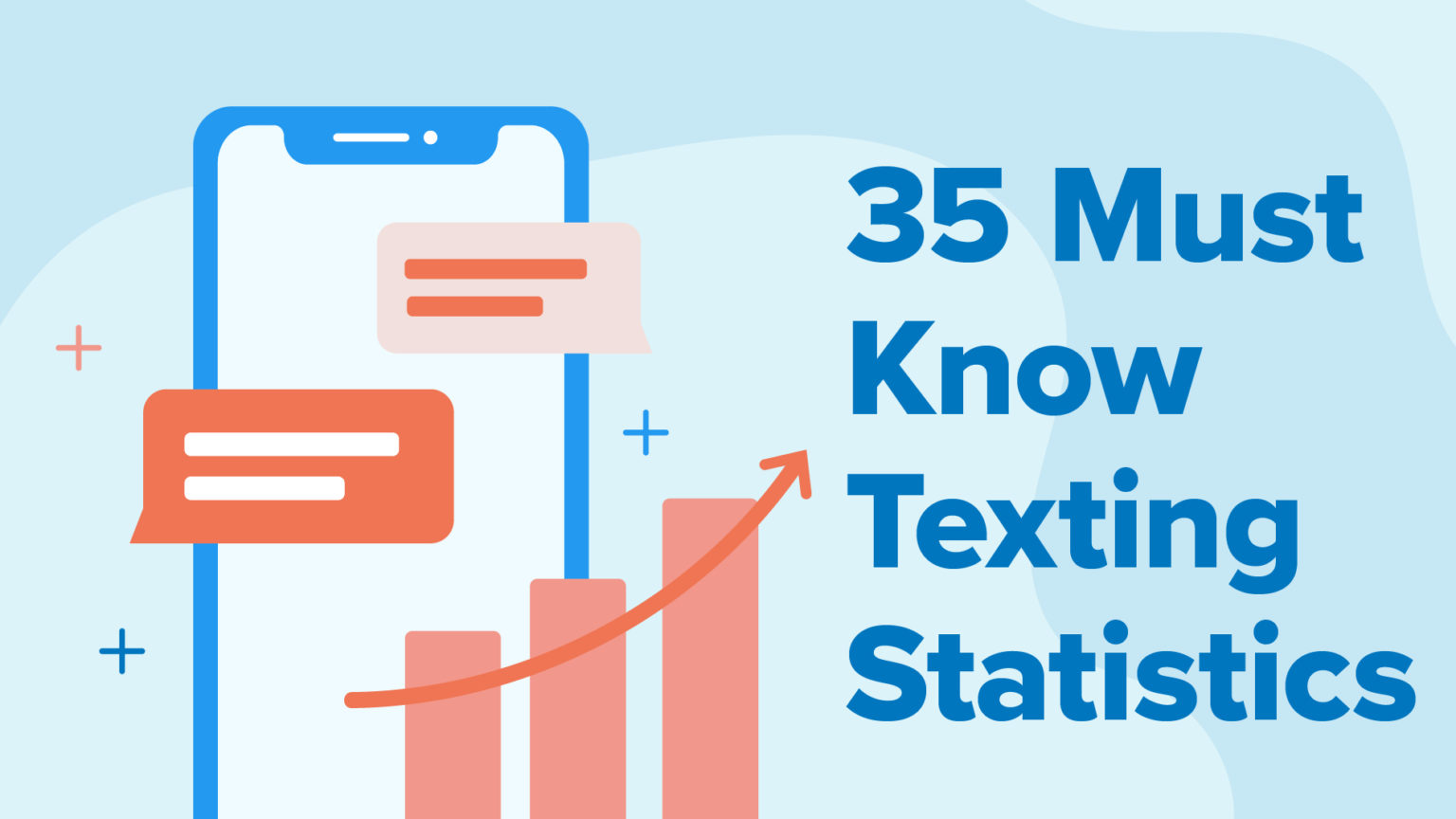
Our average screen times sky-rocketed during quarantine. Explore all the must-know 2021 texting statistics and find out how SMS marketing is on the rise.

👋 Hey there! Our 2024 SMS Marketing Survey results are in! Read the report for the most up-to-date insights on text message marketing.
During a period of rapid change, U.S. businesses were forced to quickly innovate and pivot strategies to stay afloat over the past year and some change.
Texting was leveraged for COVID-19 alerts, curbside pick-up, speedy customer support, telehealth appointment reminders, and influencer promos, among hundreds of other use cases – all in an effort to stay closely connected to consumers where they are – on their phones.
Through each of the past year’s hurdles, text marketing remained steadfast, proving itself as a valuable and efficient communication channel. As its popularity continues to rise, even amidst a global pandemic, SimpleTexting wanted to better understand how businesses and consumers across the U.S. view texting.
In our latest SimpleTexting SMS marketing report, we surveyed over 1,300 U.S. consumers, business owners, and marketers to determine their preferences and primary motivations pertaining to texting and SMS marketing.
Specifically, we asked questions surrounding:
Read on for helpful texting statistics and the full survey results.
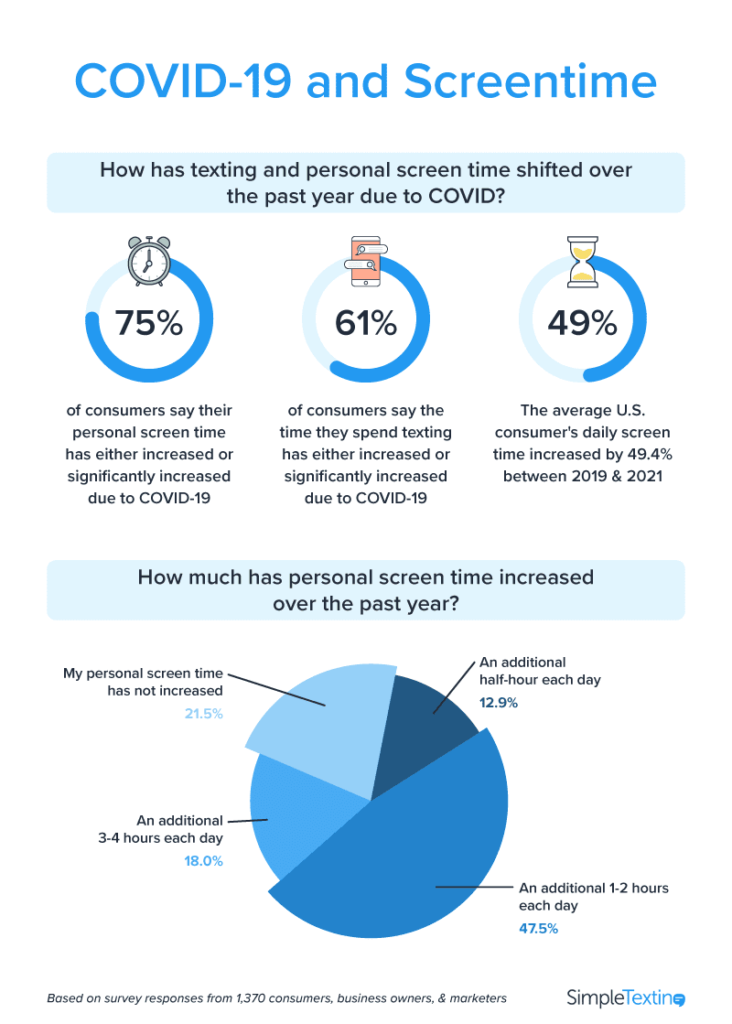
Personal screen time noticeably increased during COVID-19. In fact, the average U.S. consumer’s daily screen time increased by almost 50% between 2019 and 2021, according to our average screentime by state study.
75% of consumers surveyed admit that the time they spend on their phones has increased due to COVID, and 48% of those respondents say that time has ballooned by as much as 1-2 hours each day. The same goes for texting. 61% say that the time they spend texting each day has either increased or significantly increased due to COVID.
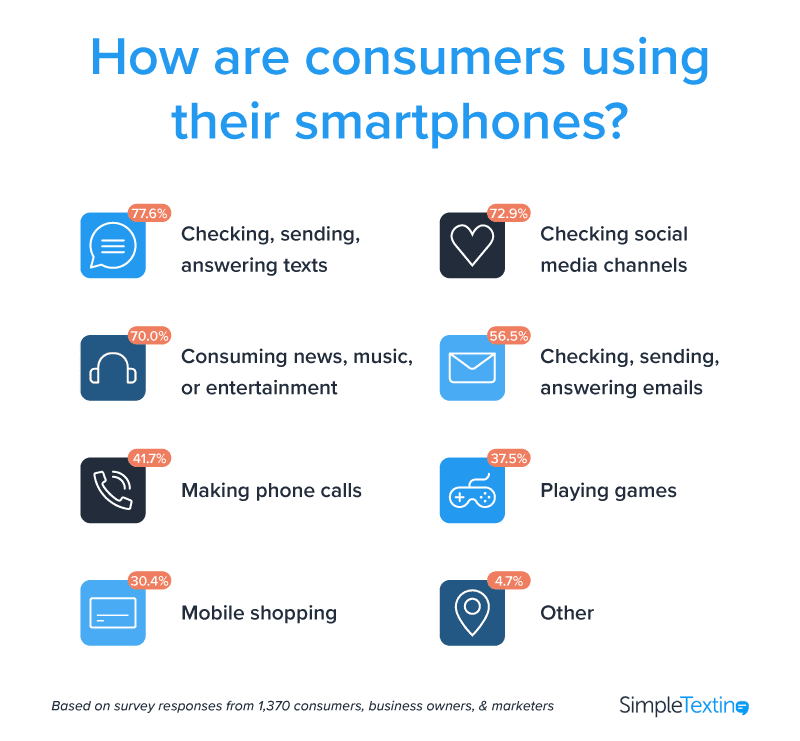
Consumers are glued to their phones, but what are they doing exactly? 78% of consumers say that checking, sending, and answering text messages is the activity they do most on their smartphones throughout the day, followed by checking social media channels (73%), and consuming news, music, or entertainment (70%).
Thus, on an average day, consumers check their text messages more than any other app on their phones. The informality and time efficiency of texting, in comparison to email or phone calls, naturally makes it an activity that consumers interact with most.
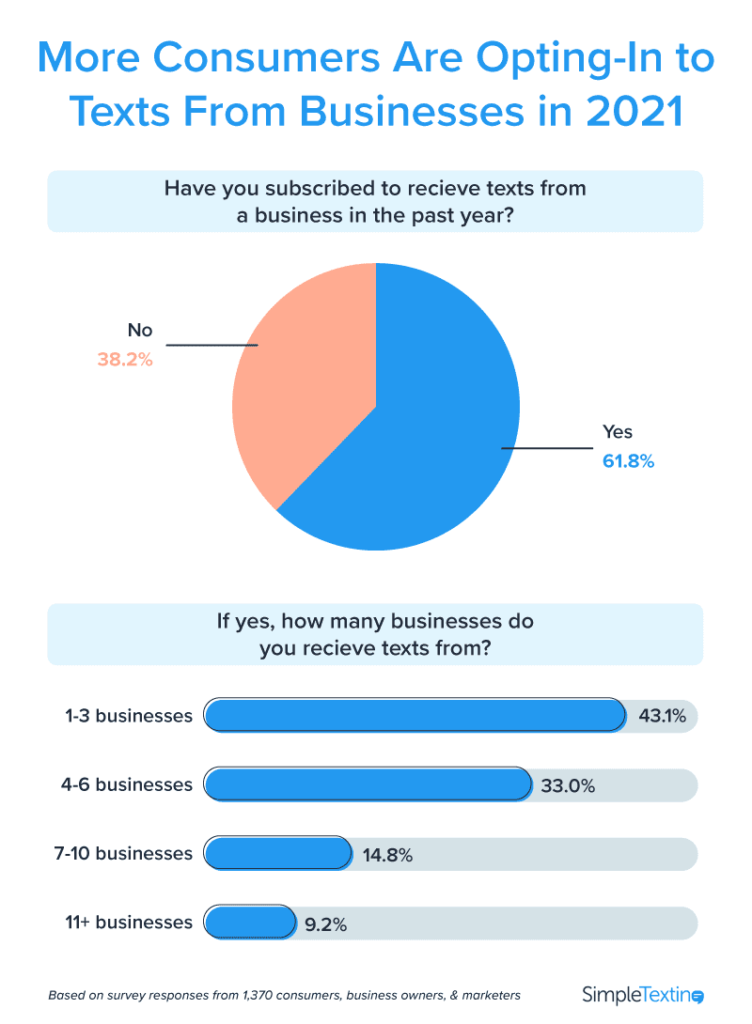
62% of consumers say they have subscribed to receive texts from at least one business in the last year. Of those consumers, 43% receive texts from 1-3 businesses and 33% receive texts from 4-5 businesses, most notably for things like appointment reminders, exclusive promotions, and sale notifications.
The rise of mobile commerce is another reason why consumers are opting in to texts from businesses. The largest portion of consumers (33%) say they make purchases from their smartphone 2-3 times per month, and 21% say they make purchases once a week or more. Specifically, 60% of Gen X consumers make mobile purchases 2-3 times a month or more frequently.
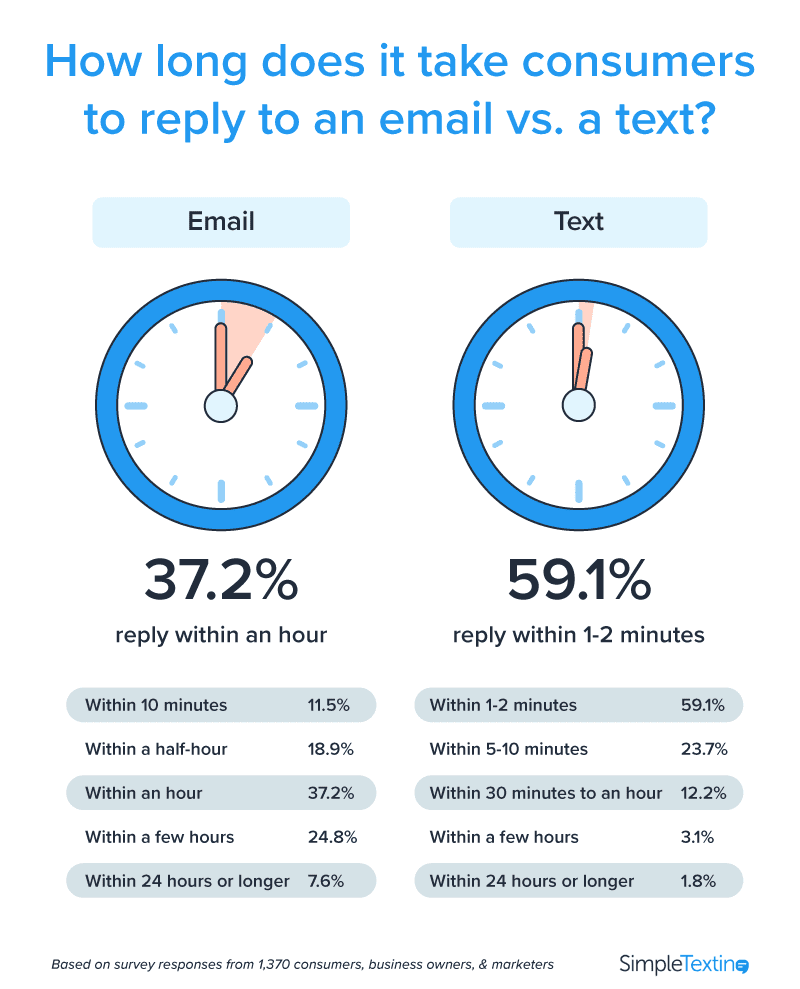
So what do reply rates look like when zooming in on text vs. email? Consumers largely reply back to an email within an hour (37.2%), and for a quarter of consumers it can take up to a few hours for them to reply back.
When we look at reply rates for texting, this time radically decreases. Almost 60% of consumers reply back to a text message within 1-2 minutes.
These stats bode well for businesses interested in texting back and forth with their customers to build stronger relationships – especially considering 56% of people would rather text a business than call customer service.
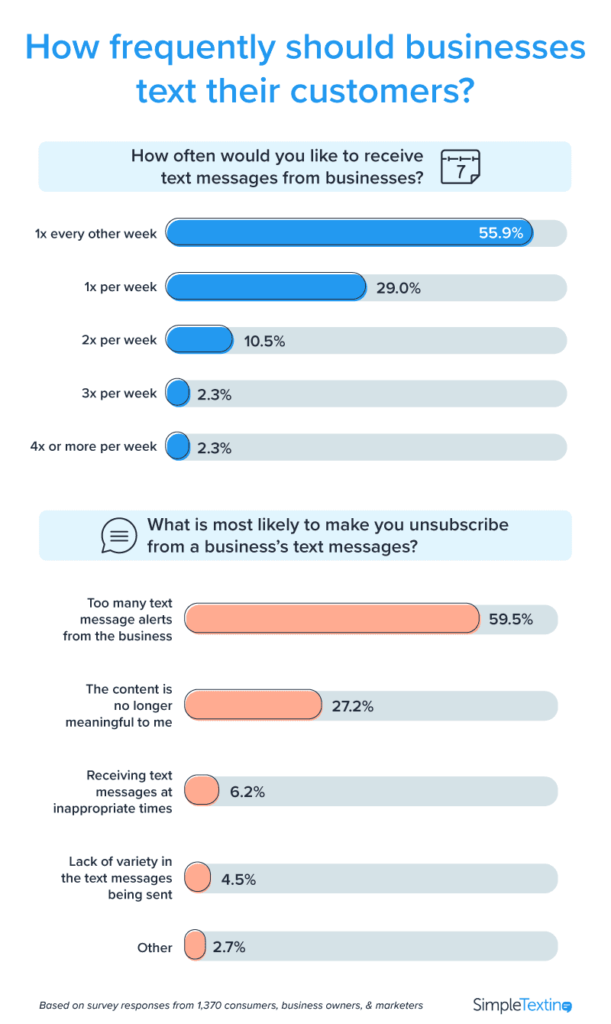
According to survey responses, text messaging cadence is key. 56% of consumers say they would like to receive texts from businesses once every other week, followed by 29% who say once per week is ideal. What’s more, the biggest reason consumers would unsubscribe from a business’s text messages is too many text message alerts.
A good rule of thumb – set expectations and avoid bombarding consumers with alerts that do not add value. When someone signs up for your texts, they should be aware of how many times per month they can expect to hear from you.
Another tip for businesses is to avoid text messages that sound overly spammy. Before you send a text, ask yourself whether it sounds like there’s a real human on the other end of the line. If the answer is yes, your customers are much more likely to reply or click on your message.
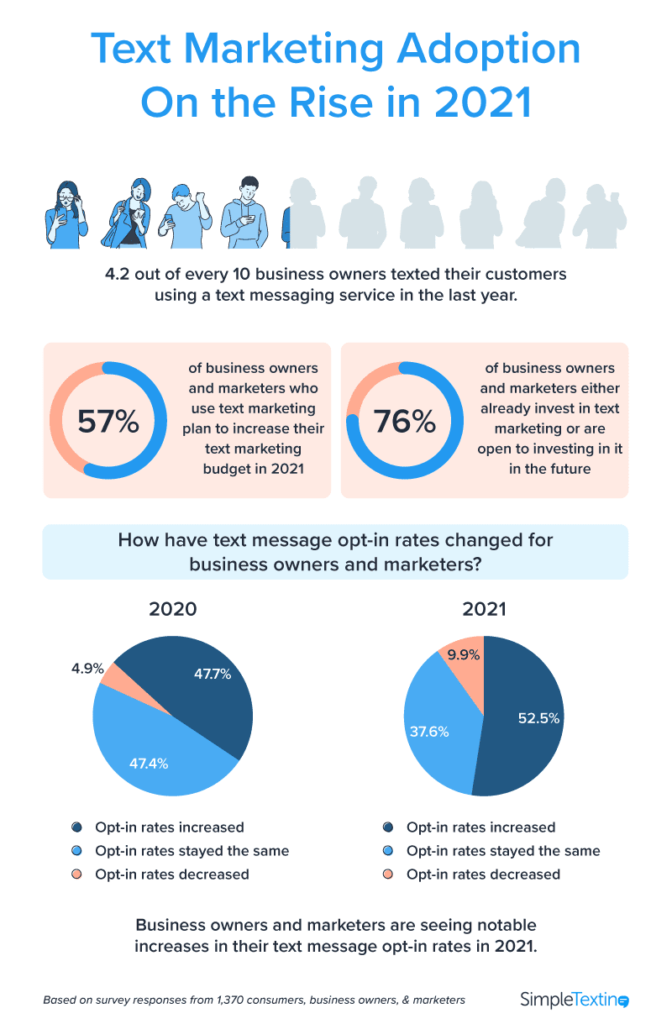
As consumer opt-in rates have increased, so have businesses signing up for text messaging services. 42% of business owners and marketers say they have texted their customers using a text messaging service in the last year, and 57% say they plan to increase their text marketing budget.
Of those who use text marketing, the majority (53%) have seen their text message opt-in rates increase in the past year, compared to 48% of business owners and marketers who said the same last year – a 9.6% increase between 2020 and 2021.
Overall, businesses are seeing the tangible benefits of text marketing in terms of their return on investment, sales conversions, and higher open and click-thru rates in comparison to other messaging channels.
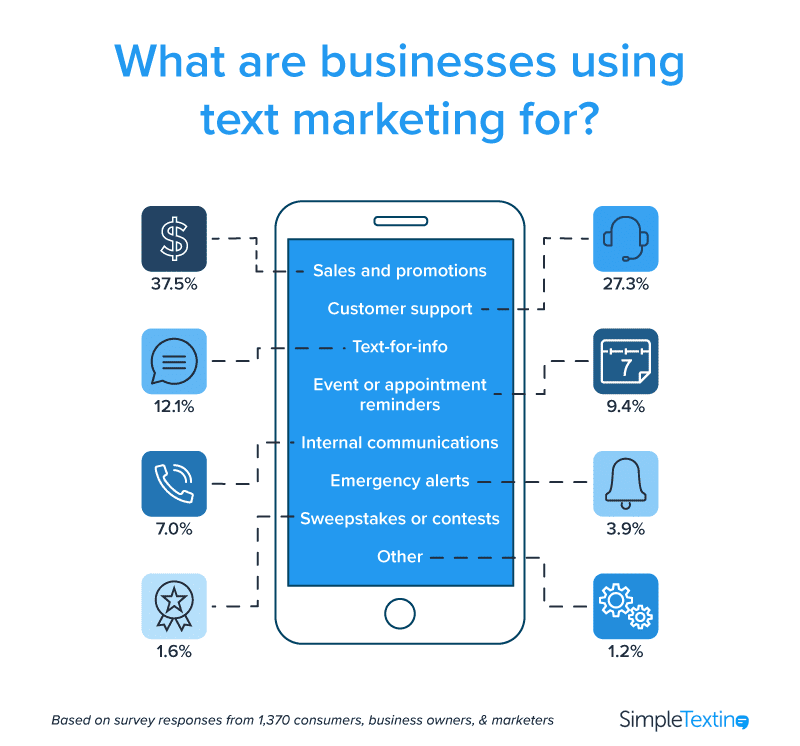
Over 1 in 3 business owners (38%) are using text marketing to boost sales and offer promotions. The sense of urgency that’s synonymous with texting works particularly well for promotions like flash sales, special offers, or time-sensitive promotions.
Over a quarter of business owners (27%) are using text marketing as part of their larger customer service strategies. More and more, SMS is expanding as a customer support tool. Consumers value mobile messaging support because it’s both responsive and convenient. Where emails and phone calls can have larger-than-life lead times, texting lets consumers and businesses connect with each other quickly and efficiently.
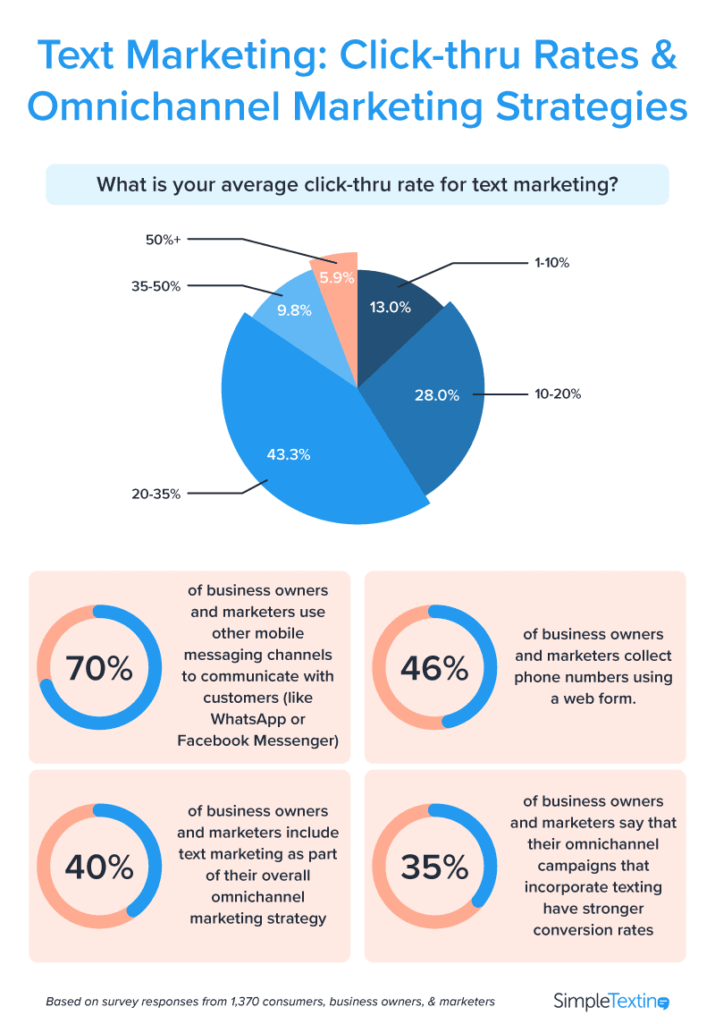
The largest portion of business owners and marketers (43%) report click-thru rates between 20 and 35%, which is significant by industry standards. Businesses are also starting to integrate texting into their larger marketing strategies.
According to survey responses, 40% of business owners include text marketing as part of their omnichannel marketing strategy, and 35% say that their omnichannel campaigns that incorporate texting yield stronger conversion rates.
That wraps up our latest SMS marketing report. Businesses should continue to be responsive to the changes brought on by the pandemic, and that includes updating the ways in which they communicate with customers.
Despite its growth, SMS continues to be one of the most underutilized marketing channels. This presents huge upsides for companies who are willing to try it.
Interested in learning more? We can get you started with text marketing in just 10 minutes. And better yet? You can try it out for free. It couldn’t be simpler!
The statistics in this report are derived from two separate surveys. We surveyed 827 U.S. consumers across a range of demographics from April 23rd to 24th, 2021, and 543 U.S. business owners and marketing managers from April 25th to 26th, 2021.
Meghan Tocci is a content strategist at SimpleTexting. When she’s not writing about SaaS, she’s trying to teach her puppy Lou how to code. So far, not so good.
More Posts from Meghan TocciHow and what we text has changed a lot over the years. Learn about what started it all back in 1992.
ReadText marketing was featured on the sports world's biggest stage as the NFL used text-2-vote to determine the Super Bowl MVP.
ReadStart a text marketing campaign or have a 1-on-1 conversation today. It's risk free. Sign up for a free 14-day trial today to see SimpleTexting in action.
No credit card required